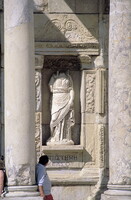| dc.coverage.spatial | Site: Ephesus, Aegean Region, Turkey | en_US |
| dc.coverage.temporal | 1970-1978 (restoration); ca. 110-135 CE (creation) | en_US |
| dc.creator | unknown (Ancient Roman) | en_US |
| dc.date | 110-135 | en_US |
| dc.date.accessioned | 2013-02-26T21:17:14Z | |
| dc.date.available | 2013-02-26T21:17:14Z | |
| dc.date.issued | 110-135 | en_US |
| dc.identifier | 196564 | en_US |
| dc.identifier.other | archrefid: 1571 | en_US |
| dc.identifier.uri | http://hdl.handle.net/1721.3/104072 | |
| dc.description | Niche with statue, center right, dedicated to Knowledge (Episteme); [The burial chamber under the floor contains the marble sarcophagus of Celsus in an excellent state of preservation.] Built in 110-135 CE, it is a monumental tomb for Gaius Julius Celsus Polemaeanus, the governor of the province of Asia; from his son Galius Julius Aquila. The grave of Celsus is beneath the ground floor, across the entrance. The building was used as a library, the scrolls of the manuscripts were kept in cupboards in niches on the walls. There were double walls [a ventilation hall] behind the bookcases, to protect the manuscripts from heat and humidity. The capacity of the library was more than 12,000 scrolls. It was the third richest library in ancient times after Alexandria and Pergamum. The facade of the library is two-storied, with Corinthian style columns on the ground floor, and behind it, there are three entrances to the building. The statues in the niches of the columns today are the copies of the originals, which were taken to the Ephesus Museum in Vienna in 1910. The statues symbolize wisdom (Sophia), knowledge (Episteme), intelligence or benevolence (Ennoia) and virtue or excellence (Arete) of Celsus. Source: Ephesus [ An OTTI Travel Company, Turkey website]; http://www.ephesus.us/ (accessed 7/13/2008) | en_US |
| dc.format.medium | stone | en_US |
| dc.rights | © Scott Gilchrist, Archivision, Inc. | en_US |
| dc.subject | architectural exteriors | en_US |
| dc.subject | rulers and leaders | en_US |
| dc.subject | Monuments | en_US |
| dc.subject | Roman Empire | en_US |
| dc.subject | educational | en_US |
| dc.subject | monument | en_US |
| dc.subject | Imperial (Roman) | en_US |
| dc.title | Library of Celsus | en_US |
| dc.title.alternative | Ephesus: Library of Celsus | en_US |
| dc.type | image | en_US |
| dc.rights.access | Licensed for educational and research use by the MIT community only | en_US |
| dc.identifier.vendorcode | 1A3-R-T-E-5-D5 | en_US |
| vra.culturalContext | Ancient Roman | en_US |
| vra.technique | carving (processes) construction (assembling) | en_US |
| vra.worktype | library (building) | en_US |
| vra.worktype | tomb | en_US |
| vra.worktype | excavation (site) | en_US |
| dc.contributor.display | unknown (Ancient Roman) | en_US |


